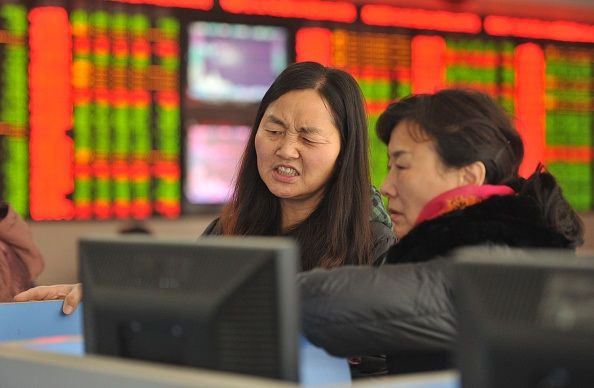China Market Fixes Face Test Day After Trading Halt

China's six-month-old campaign to calm share markets will be put to the test Tuesday, a day after selling triggered an unprecedented trading halt and risked undermining state rescue efforts estimated to have cost around $140 billion.
China's major stock exchanges tanked on the first trading day of the year on Monday, triggering a "circuit-breaker" that halted equities trade nationwide for the first time and put at risk months of regulatory work to restore market stability.
The selloff saw the CSI300 index of the largest listed companies in Shanghai and Shenzhen lose 7.0 percent before trading was suspended, its worst single-day performance since late August 2015, the depth of a summer stock market rout.
And more weakness may be in the cards on Tuesday if the behavior of a U.S. exchange-traded funds tracking mainland China shares is a guide. The Deutsche X-trackers Harvest CSI 300 China A-Shares ETF slumped nearly 10 percent in U.S. trading, hitting its lowest since October 2014, before ending the session down 8.5 percent.
Shares of several Chinese firms that trade primarily in U.S. markets, and are not subject to Chinese trading restrictions, slumped as well. Alibaba Group Holdings Ltd shed 5.6 percent and Baidu Inc. fell by 2.7 percent. The Bank of New York Mellon China ADR Index lost 4.0 percent.
The collapse, which followed the release of weak economic data, raises fresh doubts about regulators' capacity to wind back trading restrictions implemented in the wake of a summer stock market crash in which major indexes lost as much as 40 percent before Beijing intervened.
Many analysts attributed the decline to the imminent end of a six-month lockup on share sales by big institutional investors.
Major Chinese brokerages and asset management firms spent vast sums to buy up shares during the crash in a state-coordinated rescue that Goldman Sachs estimated at the time to have cost around 900 billion yuan ($138 billion).
"This is quite unexpected," said Gu Yongtao, strategist at Cinda Securities, said of Monday's fresh sell-off.
"The slump apparently triggered intensified selling, while the trigger of the circuit breaker seems to have heightened panic, as liquidity was suddenly gone and this is something no one has experienced before. It was a stampede."
Haitong Securities analysts had earlier estimated that up to 1.24 trillion yuan worth of shares would be freed up for sale by next Monday, assuming the lockup period is not extended.
The collapse in Chinese shares sent ripples across global financial markets, causing other stock markets to reel and stoking demand for safe-haven assets such as government bonds. Major U.S. equity indexes were all more than 2 percent lower around midday.
Early trading in Asia markets on Tuesday showed prices easing further.
China's yuan currency hit its lowest level in more than four years in both onshore and offshore trade on Monday, amid nervousness about weakness in Chinese manufacturing despite Beijing's surprise currency devaluation in August.
Concerns about yuan selling have prompted China to start policing its currency market in a way traders have rarely seen before, levying penalty payments for aggressive trading and prompting some banks to turn down business. The central bank has also temporarily suspended at least three foreign banks from conducting some currency business, sources say.
CONFIDENCE DASHED
China's response to the summer market crash was seen by many inside the industry as heavy handed, as it included suppression of futures and derivatives markets and instilled fear as regulators pulled in brokerage executives for questioning about insider trading and "malicious short-selling."
While that stabilized indexes, it also suppressed trading volume and poured cold water on foreign investors, who began moving out of Chinese shares.
However, authorities recently showed signs they believed indexes had stabilized, in particular by allowing initial public offerings (IPOs) to resume in November, a vote of confidence given it was a flood of IPOs that was blamed for setting off the crash in the first place.
The circuit breaker mechanism was triggered on the day it came into effect. It halts trade for 15 minutes if the CSI300 index falls or rises 5 percent in a day, then suspends trade for the day if it continues to fall or rise to 7 percent.
Chinese individual shares had already been subject to a 10 percent intraday trading range.
Some analysts doubted the efficacy of the new measure.
"Without the circuit breaker mechanism, the market wouldn't have dropped so much," said David Dai, Shanghai-based investor director at Nanhai Fund Management Co.
"The mechanism deepened investor panic, and limited trading."
Dai added that the circuit breaker would embolden market bears, as they did not have to worry about a late-session rebound. He suggested it should be scrapped or modified.
Market reforms put on hold by the crash could be delayed further if the circuit breaker fails to calm markets - which had recovered more than 25 percent from the pit of the crash prior to Monday's correction.
A sell-off could prompt regulators to re-freeze IPOs to preserve liquidity, extend the share lockup to prevent more selling, and keep the "national team" of brokerages and asset managers on the hook to keep buying and holding stocks at a loss.
It could also further dent confidence in the China Securities Regulatory Commission and in the wider financial regulatory framework to manage increasingly complex markets even as China's economy struggles against major headwinds.
(Reporting by the Shanghai Newsroom; Additional reporting by Dan Burns in New York; Editing by Sam Holmes and Mark Bendeich)
© Copyright Thomson Reuters 2024. All rights reserved.





















